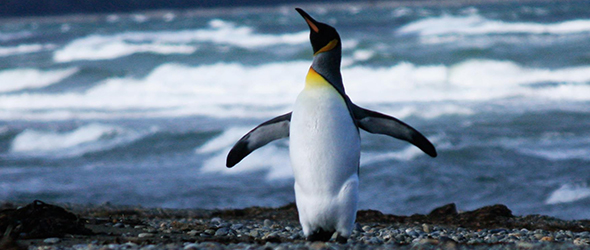
National Penguin Day is a celebration of these fascinating flightless birds, observed on April 25th every year. Every April 25th, people across the globe come together to honor and appreciate penguins.
These remarkable creatures, known for their unique appearance and playful nature, captivate the hearts of many. National Penguin Day serves as an opportunity to raise awareness about the challenges penguins face in their natural habitats and to promote their conservation.
Whether it’s the regal emperor penguins in the Antarctic or the dapper little blue penguins in Australia, each species holds its own charm and contributes to the rich biodiversity of our planet. This day also highlights the importance of protecting the fragile ecosystems that penguins rely on for survival. So, let’s celebrate National Penguin Day by learning more about these incredible birds and making efforts to ensure their future.

Credit: patagoniaadventures.com
Why Penguins Are Fascinating Creatures
Penguins, with their unique characteristics, are truly fascinating creatures. These flightless birds have adapted remarkably to extreme environments, making them highly adaptable and resilient. One of their most remarkable adaptations is their ability to withstand freezing temperatures and harsh weather conditions. Their dense feathers and layer of blubber provide excellent insulation, allowing them to thrive in cold climates. Furthermore, their streamlined bodies and flippers enable them to efficiently navigate through the water, where they spend the majority of their lives. Additionally, penguins exhibit fascinating behavioral traits and social interactions, which make them all the more captivating. They form strong bonds within their colonies and engage in various displays and rituals to communicate and establish hierarchy. The way they care for their young and work together to protect their eggs showcases their remarkable cooperative behavior. These distinctive characteristics and behaviors make penguins a subject of intrigue and admiration for nature enthusiasts worldwide.
Anatomy And Physiology Of Penguins
On National Penguin Day, it is important to understand the fascinating anatomy and physiology of these incredible creatures. Penguins have specialized adaptations that allow them to survive in their unique habitats. Their wings, beaks, and feathers are specially designed for life in the water. Their wings, known as flippers, are short and flattened which enables them to navigate through the water with agility. The beaks of different penguin species vary in shape and size, but all serve the same purpose – catching fish and other prey.
Thermoregulation is essential for penguins as they inhabit cold regions. They have a layer of blubber that helps to insulate their bodies and keep them warm. Additionally, their feathers provide protection and help to maintain body temperature. Penguins also have the ability to regulate blood flow to their extremities, allowing them to conserve heat. Their swimming abilities are truly remarkable, as they can dive to great depths and remain underwater for extended periods of time, thanks to their streamlined bodies and powerful flippers.
| Specialized adaptations for survival | Wings, beaks, and feathers | Thermoregulation and swimming abilities |
|---|---|---|
| Penguins have adapted various features to thrive in their habitats. | Penguin wings, known as flippers, aid in agile movement in water. | Thermoregulation methods like blubber and blood flow regulation help penguins survive in the cold. |
| Beaks of penguin species are specialized for catching prey. | Penguin feathers provide insulation and protection. | Penguins’ streamlined bodies and powerful flippers enable exceptional swimming abilities. |
Different Species Of Penguins
The African penguin (Spheniscus demersus) is a native species to the coasts of South Africa and Namibia. These penguins are known for their distinctive black and white feathers and a unique pink gland above their eyes. They are highly adaptable and are often found in colonies along the rocky coastlines.
Emperor penguins (Aptenodytes forsteri) are the largest species of penguins and are native to Antarctica. They are known for their ability to withstand the harshest conditions on Earth. Emperor penguins form large colonies during breeding season and rely on each other for warmth and survival.
Gentoo penguins (Pygoscelis papua) are known for their distinctive red-orange bill and white “bonnet” marking on their heads. They can be found in the sub-Antarctic regions and the Falkland Islands. Gentoo penguins are known for their agility in water and are excellent swimmers, often diving to depths of up to 200 meters.
| Penguin Species | Habitat |
|---|---|
| African Penguins | Coasts of South Africa and Namibia |
| Emperor Penguins | Antarctica |
| Gentoo Penguins | Sub-Antarctic regions and the Falkland Islands |
Habitat And Distribution Of Penguins
| Geographic range and distribution | Preferred habitats and nesting sites | Environmental threats and conservation efforts |
|---|---|---|
| Penguins are found abundantly in the Southern Hemisphere, with the majority residing in Antarctica. However, they can also be found in various locations such as South Africa, Australia, New Zealand, and the sub-Antarctic islands. | Penguins generally prefer cold climates and are often found in icy environments. They occupy coastal areas and islands, where they nest in sheltered spots such as coastal vegetation, rocky shores, or burrows. Some species prefer to nest in colonies on flat ground, while others prefer steep cliffs or in caves. | Unfortunately, penguins face numerous environmental threats due to human activities and climate change. Overfishing reduces their food supply, oil spills contaminate their habitats, and pollution affects their health. These factors, along with habitat destruction and global warming, contribute to the decline in penguin populations. To combat these threats, various conservation efforts are in place. These include protected marine areas, research initiatives, and raising awareness about the importance of preserving penguin habitats. |
Breeding And Parental Care In Penguins
Penguins are known for their unique mating rituals and courtship behavior. These rituals often involve elaborate displays and vocalizations to attract a mate. Once a pair has formed, they will remain monogamous for the breeding season.
After mating, the female penguin will lay a single egg, which is then incubated by both parents. Penguins have a unique method of egg incubation, where they take turns keeping the egg warm. This ensures that the egg is constantly protected from the harsh Antarctic weather.
Once the chick hatches, the parents continue their cooperative parenting efforts. Both parents take turns feeding and caring for the chick, ensuring it receives the necessary nourishment for growth and development. This cooperative parenting strategy allows for efficient chick rearing.
During feeding, penguins employ various feeding strategies. Some species, like the Emperor penguin, store food in their stomachs to regurgitate for their chicks. Others, like the Adelie penguin, form large feeding groups to corral fish and krill.
| Species | Mating Rituals | Egg Incubation | Feeding Strategies |
|---|---|---|---|
| Emperor Penguin | Elaborate courtship displays | Both parents take turns incubating | Regurgitation of stored food |
| Adelie Penguin | Aggressive head-shaking displays | Both parents take turns incubating | Form large feeding groups |
| Gentoo Penguin | Bow displays and vocalizations | Both parents take turns incubating | Dive for fish and krill |
Breeding and parental care are crucial to the survival of penguin populations. These remarkable birds have adapted unique strategies to ensure successful reproduction and the upbringing of their offspring.
Feeding Habits And Diet Of Penguins
Penguins are fascinating creatures that have unique feeding habits and diets. They have adapted various hunting techniques to catch their prey and have evolved specific feeding adaptations.
One of the fascinating aspects of penguins’ feeding habits is their prey preferences and foraging behavior. Different penguin species have varying food preferences, with some favoring fish, while others primarily feed on krill or squid. This diversity in diet allows penguins to thrive in different ecosystems.
Penguins showcase impressive hunting techniques to capture their prey. They are excellent divers, using their streamlined bodies and webbed feet to swim swiftly through the water to catch their food. Some species even dive to extreme depths to hunt for fish.
However, the impact of climate change on food availability is a growing concern for penguins. As ocean temperatures rise, it alters the distribution and abundance of their prey. This can lead to challenges in finding enough food for penguin populations, affecting their overall survival.
| Hunting techniques and feeding adaptations | Prey preferences and foraging behavior | Impact of climate change on food availability |
|---|---|---|
| Penguins utilize streamlined bodies and webbed feet to swim and catch prey. | Penguins have diverse diets, with some preferring fish, krill, or squid. | Climate change affects prey distribution and abundance, posing challenges for penguins to find enough food. |
| Some penguin species dive to extreme depths to hunt for fish. | Food availability influences penguin foraging behavior and feeding locations. | Changes in ocean temperatures impact the availability of prey species. |
| Penguins have evolved specialized beaks and tongues for swallowing prey whole. | Predation pressure from other marine predators also shapes penguins’ foraging strategies. | Food scarcity due to climate change can negatively impact penguin populations. |
Penguin Communication And Vocalizations
Communication is essential for penguins to interact and bond with one another. Body language and visual signals play a crucial role in conveying messages. Penguins use specific postures, such as standing tall or hunching down, to express dominance or submission. They also use visual signals like head movements and flapping their flippers to communicate various messages.
Vocalizations and calls are another important aspect of penguin communication. Different species have their distinct calls, which they use to identify one another, locate their chicks, or warn of danger. These vocalizations are often characterized by distinct pitches, tones, and rhythms.
Penguins form colonies where they interact with each other using various communication techniques, like calls, postures, and visual signals. Within a colony, they communicate about their nesting territories, sharing food, or claiming mates.
In addition, pair bonding is crucial for penguins during breeding season. They use calls and postures to establish and reinforce their bond with their mate. This communication helps them synchronize their behavior and coordinate activities like nest building, egg incubation, and feeding their young.
Penguin Predators And Threats
Penguins face several predators in their natural habitats. These include marine mammals like seals and sea lions, who prey on penguins in the water. On land, large birds such as skuas and gulls can also pose a threat to penguin chicks and eggs. Additionally, leopard seals and orcas are known to hunt penguins in the Antarctic region.
Apart from natural predators, penguins also face numerous human-related threats, which have had a severe impact on their populations. These threats include overfishing, pollution, climate change, and habitat destruction. Overfishing reduces the availability of food for penguins, while pollution can harm their health and contaminate their environment. Climate change affects penguins by causing habitat loss, altering food availability, and increasing the frequency of extreme weather events.
To combat these threats and protect penguins, various conservation initiatives have been undertaken. These initiatives focus on creating marine protected areas, promoting sustainable fishing practices, reducing pollution, and raising awareness about the importance of penguin conservation. Additionally, research efforts are conducted to better understand penguin behavior and habitat requirements, which helps in formulating effective conservation strategies.
Penguin Conservation And Research
The importance of scientific studies in penguin conservation cannot be overstated. Monitoring and tracking penguin populations is crucial in understanding their habitats, behaviors, and threats they face. By conducting thorough research, scientists can gather valuable data that aids in the development of effective conservation strategies.
Conservation organizations and initiatives play a vital role in protecting penguin species. These organizations work relentlessly to raise awareness, implement conservation programs, and collaborate with local communities to promote sustainable practices. Their efforts contribute to the preservation of penguin habitats and the overall well-being of these magnificent creatures.
Penguins In Popular Culture And Media
Penguins have cemented their place in popular culture and media, symbolizing resilience, adaptability, and a sense of uniqueness. These endearing birds have made appearances in numerous movies and books, captivating audiences with their charm and playful personalities. From the classic film “March of the Penguins” to the animated hit “Happy Feet,” penguins have taken center stage, showcasing their remarkable journeys and captivating tales. Their symbolic importance extends beyond entertainment, as penguins serve as ambassadors for educational outreach programs and raising awareness about the importance of conservation and protecting their habitats. These programs play a crucial role in educating the public about the challenges penguins face in the wild and promoting actions to ensure their survival. By leveraging their popularity, penguins have become powerful advocates for environmental stewardship and inspiring future generations to become more involved in conservation efforts. Through their representation in popular culture and their role as ambassadors, penguins leave a lasting impact on our society and remind us of the importance of conservation.
Unique Experiences With Penguins
Looking for unique experiences with penguins? National Penguin Day provides numerous opportunities for penguin encounters that are both educational and enjoyable.
Visiting penguin colonies and sanctuaries is a great way to get up close and personal with these fascinating creatures. Many locations around the world offer guided tours, where you can observe penguins in their natural habitat and learn about their behaviors and conservation efforts. From the icy shores of Antarctica to the picturesque landscapes of New Zealand, there are plenty of destinations to choose from.
For those passionate about penguin conservation, volunteering at penguin sanctuaries is an incredibly rewarding experience. By contributing your time and skills, you can help rehabilitate injured or orphaned penguins and contribute to their overall well-being. It’s a hands-on way to make a difference and support these amazing animals.
Frequently Asked Questions Of National Penguin Day
Why Do We Celebrate National Penguin Day?
We celebrate National Penguin Day to raise awareness about these fascinating birds and their conservation.
Is April 25th Penguin Day?
No, April 25th is not Penguin Day.
How Do We Celebrate World Penguin Day?
Celebrate World Penguin Day by learning about these amazing creatures, sharing penguin facts on social media, and supporting conservation efforts.
Is January 20th National Penguin Day?
No, January 20th is not National Penguin Day. National Penguin Day is celebrated on April 25th to raise awareness about penguins and their conservation.
Conclusion
Penguins are fascinating creatures that captivate our hearts and remind us of the delicate balance of nature. National Penguin Day celebrates these adorable waddlers, highlighting their unique characteristics and the importance of conserving their habitat. From their sleek feathers to their happy dances, penguins are a symbol of resilience and adaptability.
By raising awareness and supporting conservation efforts, we can ensure the survival of these remarkable birds for future generations to enjoy. Embrace the spirit of National Penguin Day and join the movement to protect these incredible creatures.






